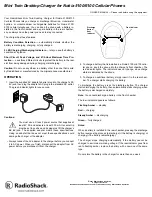
Automation Components, Inc.
2305 Pleasant View Road | Middleton, WI 53562
Phone:
1-888-967-5224 |
Website:
workaci.com
Page 1
Version: 6.0
I0000694
RT2630 SERIES
Installation & Operation Instructions
Phone:
1-888-967-5224
Website:
workaci.com
transmission has been received successfully. The Link LED will continue to blink once for every data
transmission. The data transmission rate is programmed into the sensor (normally 1 minute intervals). To
manually initiate a data transmission, press the push button switch located by the negative terminal of the
battery.
Once the location has been determined, mount the RT2620 remote transmitter on a wall using four #8
screws(see
Figure 1
(p.3) for mounting dimensions). Determine if the RT2620 remote transmitter will be
powered by 24VAC or by the batteries on a permanent basis.
WIRING INSTRUCTIONS
WIRING PRECAUTIONS
• Remove power before wiring. NEVER connect or disconnect wiring with power applied.
• The RT2630 is full wave rectified using 24 VAC.
• It is recommended that you use an isolated UL-listed Class 2 transformer when powering the unit
with 24 VAC. Failure to wire the devices with the correct polarity when sharing transformers may
result in damage to any device powered by the shared transformer.
Observe polarity when connecting
analog outputs to the controller inputs.
For 24V Operation
If the device is to be powered by 24V (AC or DC depending on model), move the voltage selection
jumper to 24VAC position, and connect 24V to the input terminals using 16-26 AWG wire.
For Battery Operation
If the device is to be powered using the 3.0 volt batteries—remove the voltage selection jumper(see
Figure 1
) and reposition it for battery operation.
Note:
The device is shipped with the voltage selection jumper installed in the 24VAC position.
For proper operation, it is important to use the correct type of battery. Size: 2/3A, Lithium 3.0V 1400mAh
(e.g. Duracell DL123A) batteries.
Sensor Inputs
Wire the sensor inputs to the appropriate terminals using 18AWG wire.
Attach the cover using the four screws.
CAUTION
DO NOT USE THIS PRODUCT IN ANY SAFETY RELATED APPLICATIONS WHERE HUMAN
LIFE MAY BE AFFECTED.
GENERAL INFORMATION
The RT2630 wireless remote Analog/Digital Sensor Input Concentrator accepts analog and digital sensor/control
inputs and transmits wirelessly to the receiver.
ACI’s mesh network wireless Analog and Digital Sensor Input Concentrators utilize reliable Spread Spectrum Radio
technology. They can be installed easily in minutes, eliminating hundreds of feet of wire and saving installation cost
while reducing installation labor risks.
The sensor Data-Link LED confirms the data transmission was received by the receiver for fast and reliable
positioning of the sensor during installation. There is no need for special wireless installation equipment or tool.
Together with the ACI receivers and controllers, the ACI wireless sensors can be used with any LON works, BACnet,
Modbus, or DDC control system or panel.
The maximum radio transmission distance is dependent on the building type. In a typical commercial
building with steel I-Beam construction, concrete floors with reinforcing rod, and metal stud walls, it can be
expected that transmissions will penetrate vertically typically one floor below and one floor above a
transceiver/receiver, and horizontally through 200 to 300 feet of walls, furniture and air.
Installation
Wireless sensors should be installed within 200 to 300 feet of the receiver. RR2552 signal repeaters can
be installed as to increase transmission distance between sensors and receivers.
PRECAUTIONS
SENSORS, REPEATERS AND RECEIVERS SHOULD NOT BE INSTALLED IN THE FOLLOWING AREAS:
• INSIDE METAL ENCLOSURE / PANEL
• INSIDE OR IMMEDIATELY NEXT TO ELEVATOR SHAFT / ELEVATOR BANKS
• IN FRONT OF OR IMMEDIATELY NEXT TO LARGE TREES OR LARGE BODY OF WATER
TRANSMISSION DISTANCE AND PERFORMANCE WILL BE DRASTICALLY REDUCED
CAUTION
Observe battery polarity when installing battery.
MOUNTING INSTRUCTIONS
Take the RT2620 to the area it is to be installed. Insert the battery, observing polarity. Move the Jumper to
“BATT”.
While the sensor is attempting to connect to the receiver the Link LED will blink rapidly 8–10 times every
10 seconds. Once a connection has been established the Link LED will blink once to indicate the data
!
!






















